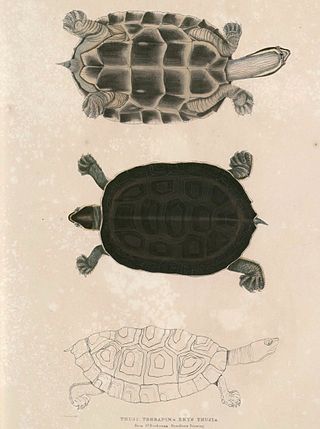
Asaccus is a genus of geckos, commonly known as Southwest Asian leaf-toed geckos, in the family Phyllodactylidae.

Trimeresurus albolabris, the white-lipped pit viper or white-lipped tree viper, is a venomous pit viper species endemic to Southeast Asia.

The black pond turtle, also known commonly as the spotted pond turtle and the Indian spotted turtle, is a species of freshwater turtle in the family Geoemydidae. The species, which is endemic to South Asia, belongs to the monotypic genus Geoclemys.

The brahminy river turtle or crowned river turtle is a species of turtle in the family Geoemydidae. The species is endemic to South Asia.
The Namoi River snapping turtle, also commonly known as Bell's turtle, the Namoi River elseya, or Bell's saw-shelled turtle, is a species of turtle in the family Chelidae. The species is endemic to New South Wales, Australia.

Phrynocephalus persicus, commonly known as the Persian toad-headed agama, is a small diurnal desert lizard of the family Agamidae. It is the westernmost representative of the Central Asian genus of toad-headed agamas Phrynocephalus and is only known from deserts and semideserts of Iran and possibly Azerbaijan.

Brookesia confidens, also known as the leaf chameleon, is one of the world's smallest species of chameleons. It is endemic to the Ankarana Nature Reserve in Madagascar. It was first described in 2012 by F. Glaw, J. Koehler, T.M. Townsend and M. Vences.

Asaccus elisae, also known as Elisa's leaf-toed gecko or Werner's leaf-toed gecko, is a species of gecko, a lizard in the family Phyllodactylidae. The species is native to the Middle East.
Hemidactylus mandebensis is a species of house gecko from Yemen. It grows to 42 mm (1.7 in) in snout–vent length. It is a relatively small-sized member of the Hemidactylus robustus species group.
Acanthodactylus nilsoni, commonly called Nilson's spiny-toed lizard, is a species of lizard in the family Lacertidae. The species is endemic to Iran.
Parsigecko is a monotypic genus of lizards in the family Gekkonidae. It contains one species, Parsigecko ziaiei, known as Ziaie's Pars-gecko. It is found in southern Iran.
Natalie's toad-headed agama is a species of agamid lizard endemic to the Zagros Mountains in Iran. The specific epithet honors Natalia Ananjeva of the Zoological Institute in St. Petersburg, Russia for her contribution to herpetological research of the family Agamidae and Phrynocephalus in particular.

Eremias persica, the Aralo-Caspian racerunner or Persian racerunner, is a species of lizard native to Iranian Azerbaijan, most of Iran, southern Turkmenistan, Afghanistan, and western Pakistan. Eremias intermedia is also known as the Aralo-Caspian racerunner.
Iranolacerta zagrosica, also known commonly as the Zagros Mountains lacerta, is a species of lizard in the family Lacertidae. The species is endemic to Iran.
Asaccus andersoni is a species of leaf-toed gecko endemic to Iran, on the western slopes of the central Zagros Mountains. It lives in on rocks in gullies of mountainous oak forests. It is named in honor of Steven Clement Anderson, in recognition of "his major contributions to the knowledge of the herpetofauna of the Middle East and the Iranian Plateau in particular".

Asaccus granularis is a species of leaf-toed gecko endemic to Iran. The specific epithet refers to the granular scales on the back of this lizard. It is only known from the type locality in Lorestan Province, Iran. It was found in a mountainous area with open oak forests, on rocky outcrops and under large boulders.
The Kermanshah leaf-toed gecko is a species of gecko endemic to Iran. It is named for the type locality, north of Kermanshah, eastern Kermanshah Province, in the Zagros Mountains of western Iran. It is found in caves and rock crevices at 1,400 m (4,600 ft).

Asaccus nasrullahi, Nasrullah's leaf-toed gecko, is a species of gecko in the family Phyllodactylidae. The species is endemic to Iran. The specific name nasrullahi was chosen in honor of Iranian herpetologist Nasrullah Rastegar-Pouyani, "in recognition of his contribution to the knowledge of the herpetology of Iran, including the genus Asaccus".
Asaccus tangestanensis is a species of leaf-toed gecko endemic to Iran. This gecko is found in the southern Zagros Mountains in Bushehr Province. It is found in cliffs and caves. The holotype was collected in 2008 and the species is named for Tangestan, the type locality.

The Persian snake skink is a species of skink endemic to Iran. A specimen collected in 1999 was found on sandy clay soil near Artemisia shrubs. It was originally described in 1867 as Hemipodion persicum.









